|
|
|||
THIS WEEK at HILTON POND
22-31 August 2006
Installment #326---Visitor #
(Back to Preceding Week; on to Next Week)
|
WHEN IT'S DREARY AND COLD |
|
LONG LIVE OUR HUMMINGBIRDS!
When we give hummingbird talks around the U.S., people are always very curious about these little balls of fluff that delight us at sugar water feeders spring through fall. Certain hummingbird facts--if we happen to forget to mention them in our presentation--almost always come up in the question-and-answer period that follows. "How fast does a hummingbird flap its wings?" "How fast is its heart rate?" And, "How long does a hummer live?" Our answers to the first two questions are based on the work of others who have found: 1) On average, a hummer flaps about 60-80 times per second in normal flight, up to 200 per second at top speed; and, 2) A hummingbird heart beats 250 times per minute when at rest, up to 1,220 beats per minute when flying. Our response to the third question comes mostly from our 23-year study of Ruby-throated Hummingbirds at Hilton Pond Center; to it we usually respond: "A hummingbird can live a lot longer than you might think!"
All text, tables & photos © Hilton Pond Center One of the rewarding things about long-term natural history studies is they do allow us to learn things we might not discover in a shorter, two- or three-year project. Unfortunately, short-duration projects are typical of those done by grad students who complete a thesis or dissertation and then--out of necessity in finding a job or a post-doc--go off to investigate some other topic somewhere else. Indeed, compared to the number of scientists in the U.S., precious few truly long-term studies exist--quite unlike places in Europe where some field projects are entering their second century. We've had the advantage of living and working at Hilton Pond for 25 years, and the pleasure of capturing and banding Ruby-throated Hummingbirds for almost that whole time, so our hummer project is beginning to qualify as one of those "long-term" studies. Despite the fact that we've banded more than 3,300 RTHUs at the Center since July 1984, we were still ecstatic on 28 August 2006 when we captured the adult male ruby-throat in the photos above and below right. What was so special about this particular hummer? Well, he was banded at Hilton Pond--probably as a local fledgling--on 30 August 2002--almost four years to the day before we caught him this week. To us, this is an absolutely remarkable piece of information. It seems impossible that a Ruby-throated Hummingbird that feeds on sugar water, flower nectar, and tiny insects; hovers and flies backwards and even upside-down; builds nests out of spider webs and lichens; hatches from an egg the size of a gourmet jelly bean; weighs less than a nickel; migrates perhaps 1,500 miles from York to Central America; and then comes back the following year to the very same feeder at Hilton Pond Center can live for at least four years--despite having to make that perilous long-distance migratory flight each fall and spring. Oh, ain't nature grand and mysterious! This particular hummingbird (Y15190) was also of interest because he exhibited rather heavy throat molt. From late March through early September at Hilton Pond, gorgets of nearly all our adult male Ruby-throated Hummingbirds are the uniform metallic red that gives the species its common name. Occasionally, in late summer we'll capture an adult male with a few "pin feathers," but as revealed in the top two photos, old number Y15190 had more than 20 gorget feathers still "in sheath." (NOTE: The red coloration of the bird's bill in the top photo is caused by a reflection from its gorget; a ruby-throat's bill is dark brownish-black.) By the way, in late summer it's not uncommon to capture an otherwise "white-throated" female-mimicking juvenile male that's bringing in a red feather or three (above left). Young males also can have a varying degrees of greenish or blackish streaking on their throats as shown here--sometimes giving the appearance of a "five-o'clock shadow." When we caught number Y15190 the first time back on 30 August 2002, it was with a pull-string trap attached to the trunk of an Eastern Red Cedar just outside our office window at Hilton Pond Center. As he entered the trap to drink from the feeder hanging within, a fast tug on a fishing line attached to the door safely snared him and allowed us to hold him temporarily for measurements and banding. At that time he already had two red gorget feathers--perhaps a predictor of the "early" molt we observed this year--and he weighed 2.99g, which is about normal for a male ruby-throat. This year, when we caught him in a mist net at 6:15 p.m. on 28 August, he weighed a whopping 4.93g and had subcutaneous yellow fat in his furcular (wishbone) region--a sure sign he was getting ready to migrate and likely would be gone the next day. Since his other initial returns--8 May 2003, 3 May 2004, and 15 April 2004--all happened in the spring, we might have concluded Y15190 only passed through Hilton Pond in migration, but a closer scrutiny of our records indicated he was also recaptured several times in June and July--a sure sign he bred somewhere on the property, or close by.
We're particularly glad we were running mist nets around our hummingbird feeders on the evening of 28 August this year, otherwise we might have missed seeing number Y15190 and being able to say he was our first-ever ruby-throat banded as a hatch-year male that returned to Hilton Pond four more years in a row. But, as a bonus, just an hour later in the same net we snared another returning ruby-throat, this time an adult female with band Y15311 on her right leg. Our records showed this bird was first captured locally as an adult on 8 June 2003, making her an after-fourth-year bird that was at least as old as the fifth-year adult male we had just recaptured and released. This particular female was not our oldest-ever, but she was unusual in that her throat had feathers with dark center spots (above). Like the adult male that preceded her into the net, she was also exhibiting molt, with white tips of a few pinfeathers peeking out from the gorget; her forehead likewise bore several feathers in quill. Even though Y15311 showed dark spots on her gorget, more typical female ruby-throats of any age have throats of pure white or with almost undetectable faint grayish streaking (above right); old females may occasionally have one or two solid black throat feathers. (We've even heard reports--but have never observed--that very, very rarely an old female will sport a misleading red gorget feather.) We were a bit surprised by the tail condition of Y15311 when we recaptured her this week. Instead of having the nice set of ten rounded rectrices expected in an adult female, all of her white-tipped tail feathers were heavily worn (below)--not exactly what she might want as she heads out soon on her next long trip across the Gulf of Mexico.
We might mention that--contrary to common belief--white tail tips do not occur exclusively among females in Ruby-throated Hummingbirds. Although adult males have rectrices that are black and pointed (below left), hatch-year males--like females of any age--have white outer tail tips. Thus, from early summer through autumn it's never correct to say when observing your feeders that ALL the ruby-throats with white throats and white tail tips are females; All this brings us back to the question "How long does a hummingbird live?" In reality, no one knows for sure, but we do have this week's fifth-year male and after-fourth-year female at Hilton Pond Center that tell us they live at least five years. However, these aren't our oldest birds on record, as shown by the table below. (The table only includes birds four years old or older; nearly all birds listed returned in more than one later year).
The most telling bird on our list is the one at the bottom. This particular hummer was banded at Hilton Pond as an adult female on 30 May 1997 and was recaptured every year through 2002, proving that Ruby-throated Hummingbirds live at least into their seventh year. Again, we find this to be amazing, but according to the federal Bird Banding Laboratory in Laurel MD, the record holder for longevity among ruby-throats is actually a banded bird last captured when it was at least nine years and one month. This alone boggles the mind, but even this old bird pales beside the oldest recorded hummer for any species--a Methuselah of a Broad-tailed Hummingbird captured every year but one for 12 years!
Among Ruby-throated Hummingbirds hatched out in the U.S. and Canada in 2006, the vast majority--perhaps as much as 70-80%--won't make it through their first winter. These hapless youngsters die from a plethora of causes: Disease, genetic deficiencies, inability to find food, various aberrational behaviors, predation, flying into picture windows, being eliminated by aggressive adult males, or getting lost (or "hurricaned") in their first migration. And--as shown by the table above--females survive at a much higher rate than males. A respectable 376 of our 3,284 ruby-throats banded through 2005--that's 11.4%--HAVE survived to return to Hilton Pond Center in at least one later year, and each bird that comes back gives us scientific reward and personal pleasure when it shows up again and again with an "old" band on its leg. We can't yet lay claim to hosting the oldest Ruby-throated Hummingbird, but with another 23 years or so tacked onto our current long-term study we may just get a hummer that breaks the current longevity record. Heck, by then we may even be the oldest living hummingbird bander! Long Live Our Hummingbirds!
All text, tables & photos © Hilton Pond Center Comments or questions about this week's installment?
Thanks to the following fine folks for recent gifts in support of Hilton Pond Center for Piedmont Natural History and/or Operation RubyThroat: The Hummingbird Project. Your contributions allow us to continue writing, photographing, and sharing "This Week at Hilton Pond." (See Support if you'd like to make a gift of your own.)
"This Week at Hilton Pond" is written & photographed You may wish to consult our Index of all nature topics covered since February 2000. You can also use our on-line Hilton Pond Search Engine at the bottom of this page. For a free, non-fattening, on-line subscription to |

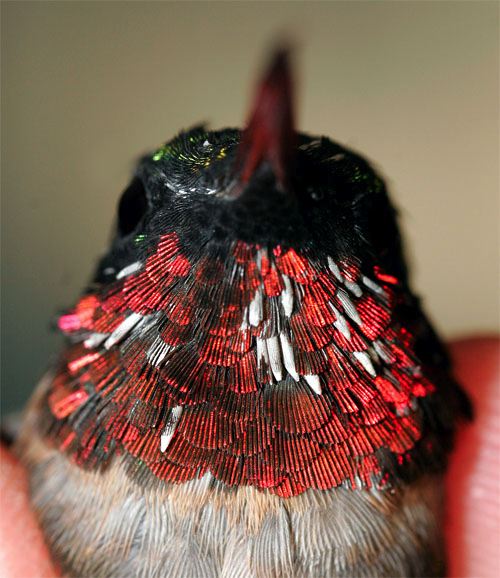
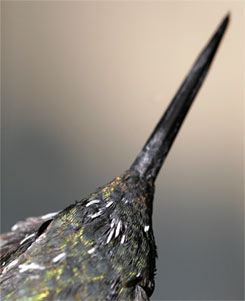 And, as icing on the cake, we can report this site-faithful little hummer was also recaptured locally in 2003, 2004, and 2005. So how long can a hummingbird live? According to this hummer wearing band number Y15190, they can live at least into the fifth year!
And, as icing on the cake, we can report this site-faithful little hummer was also recaptured locally in 2003, 2004, and 2005. So how long can a hummingbird live? According to this hummer wearing band number Y15190, they can live at least into the fifth year!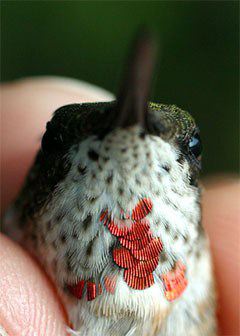 He also was replacing several new forehead feathers, all in all looking as if he might be getting a jump start on acquiring new adult male attire--perhaps to help him defend a feeding territory when he gets to his wintering grounds in the tropics.
He also was replacing several new forehead feathers, all in all looking as if he might be getting a jump start on acquiring new adult male attire--perhaps to help him defend a feeding territory when he gets to his wintering grounds in the tropics.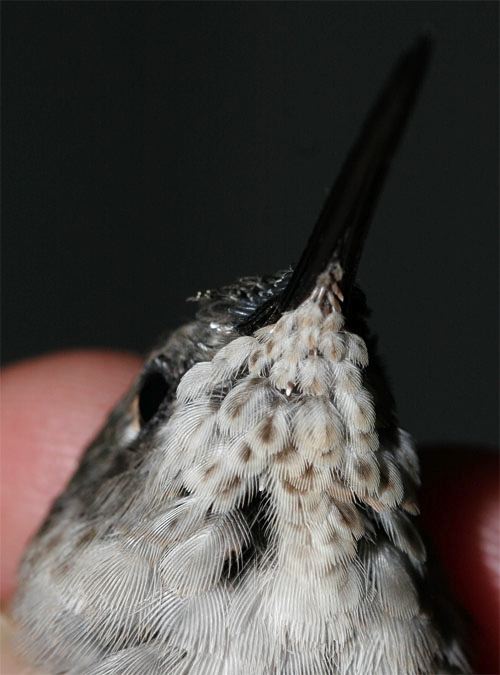
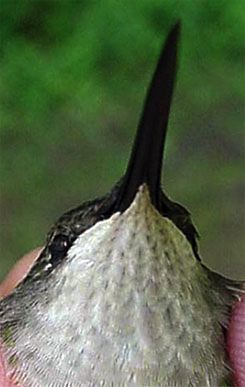 There was no way to know how old she really might be, but--interestingly enough--after banding her in 2003 and recapturing her in July 2004 we didn't see her again until this week, even though she, too, was a probable summer resident.
There was no way to know how old she really might be, but--interestingly enough--after banding her in 2003 and recapturing her in July 2004 we didn't see her again until this week, even though she, too, was a probable summer resident.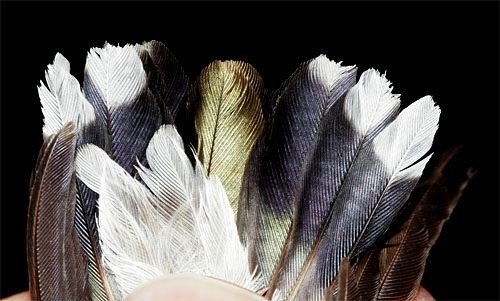
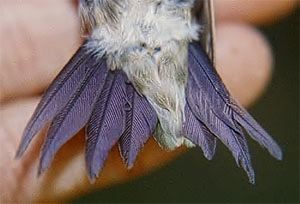 more than likely a good percentage of them are actually juvenile males--whose masquerade as females is near-perfect.
more than likely a good percentage of them are actually juvenile males--whose masquerade as females is near-perfect.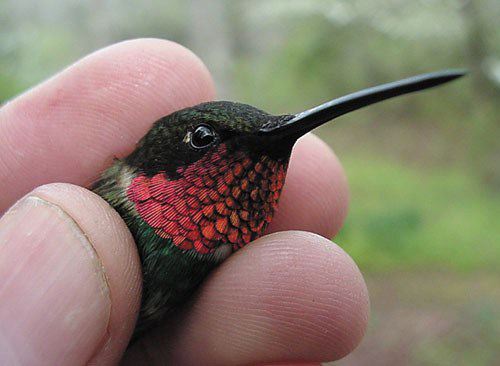


 Please report your
Please report your
